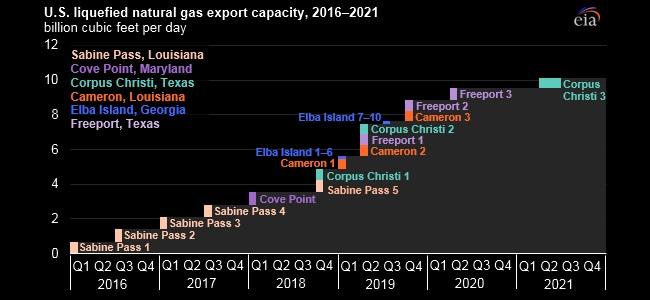
U.S. LNG WILL UP

U.S. EIA - EIA projects that U.S. liquefied natural gas (LNG) export capacity will reach 8.9 billion cubic feet per day (Bcf/d) by the end of 2019, making it the third largest in the world behind Australia and Qatar. Currently, U.S. LNG export capacity stands at 3.6 Bcf/d, and it is expected to end the year at 4.9 Bcf/d as two new liquefaction units (called trains) become operational.
The United States began exporting LNG from the Lower 48 states in February 2016, when the Sabine Pass liquefaction terminal in Louisiana shipped its first cargo. Since then, Sabine Pass expanded from one to four operating liquefaction trains, and the Cove Point LNG export facility began operation in Maryland. Two more trains—Sabine Pass Train 5 and Corpus Christi LNG Train 1—began LNG production this year, several months ahead of schedule, and are expected to ship their first cargos within the next few weeks.
Two more LNG export facilities—Cameron LNG in Louisiana and Freeport LNG in Texas—are currently being commissioned. Commissioning of liquefaction facilities involves introducing natural gas feed into the train and ultimately producing LNG. For liquefaction terminals, which use refrigeration to cool natural gas into liquid form, commissioning also includes getting the equipment and refrigerants down to sufficiently cold temperatures. The first LNG production from these facilities is expected in the first half of 2019. The developers of these projects expect all three trains at Cameron LNG and two trains at Freeport LNG to be placed in service in 2019.
The Elba Island LNG facility near Savannah, Georgia, is also scheduled to become fully operational by the end of 2019. Elba Island LNG consists of 10 small modular liquefaction units with a combined capacity of 0.33 Bcf/d. Project developers expect LNG production from the first train to begin early next year and from the remaining nine trains to commence sequentially through the rest of 2019. The second train at Corpus Christi LNG is scheduled to be placed in service in the second quarter of 2019. The final two trains of the U.S. liquefaction projects currently under construction—Freeport Train 3 and Corpus Christi Train 3—are expected in service in the second quarters of 2020 and 2021, respectively.
Four additional export terminals—Magnolia LNG, Delfin LNG, Lake Charles, Golden Pass—and the sixth train at Sabine Pass have been approved by both the U.S. Federal Regulatory Commission and the U.S. Department of Energy, and they are expected to make final investment decisions in the coming months. These proposed projects represent a combined additional LNG export capacity of 7.6 Bcf/d.
U.S. LNG exports continue to increase with the growing export capacity. EIA's latest Short-Term Energy Outlook forecasts U.S. LNG exports to average 2.9 Bcf/d in 2018 and 5.2 Bcf/d in 2019 as the new liquefaction trains are gradually commissioned and ramp up LNG production to operate at full capacity.
-----
Earlier:

2018, December, 10, 08:40:00
U.S. GAS PRICES UP AGAINBHGE - On November 23, the natural gas spot price at the Henry Hub in Louisiana was $4.70 per million British thermal units (MMBtu), the highest price since a temporary spike in January 2018, and before that, the highest price since June 2014.
|

2018, December, 3, 11:55:00
U.S. PRODUCTION: OIL +1.1%, GAS +1.8%U.S. EIA - Crude oil production increases 1.1% in September from 11,346 to 11,475 thousand barrels/day , gas production increases 1.8% from 102,659 to 104,461 million cubic feet/day .
|

2018, December, 3, 11:50:00
U.S. GAS PRODUCTION UP BY 13.8%U.S. EIA - In September 2018, for the 17th consecutive month, dry natural gas production increased year to year for the month. The preliminary level for dry natural gas production in September 2018 was 2,590 billion cubic feet (Bcf), or 86.3 Bcf/d. This level was 10.5 Bcf/d (13.8%) higher than the September 2017 level of 75.8 Bcf/d.
|

2018, November, 30, 11:40:00
U.S. OIL GAS RESERVES 2017U.S. EIA - Proved reserves of crude oil in the United States increased 19.5% (6.4 billion barrels) to 39.2 billion barrels at Year-End 2017, setting a new U.S. record for crude oil proved reserves. The previous record was 39.0 billion barrels set in 1970. Proved reserves of natural gas increased by 123.2 trillion cubic feet (Tcf) (36.1%) to 464.3 Tcf at year-end 2017—a new U.S. record for total natural gas proved reserves. The previous U.S. record was 388.8 Tcf, set in 2014.
|

2018, November, 28, 12:55:00
U.S. ENERGY PRESSUREFT - in the third quarter of this year the US E&P sector was able to cover its capital spending from its operating cash flows, if only barely. The plunge in oil prices over the past two months is bringing those concerns gushing to the surface again.
|

2018, November, 28, 12:40:00
U.S. SUBSTANTIAL DAMAGESPLATTS - Overall, the report found that without more significant global mitigation, "climate change is projected to impose substantial damages on the US economy, human health and the environment."
|

2018, November, 14, 12:00:00
U.S. PRODUCTION: OIL + 113 TBD, GAS + 1,038 MCFDU.S. EIA - Crude oil production from the major US onshore regions is forecast to increase 113,000 b/d month-over-month in December from 7,831 to 7,944 thousand barrels/day , gas production to increase 1,038 million cubic feet/day from 74,041 to 75,079 million cubic feet/day . |





